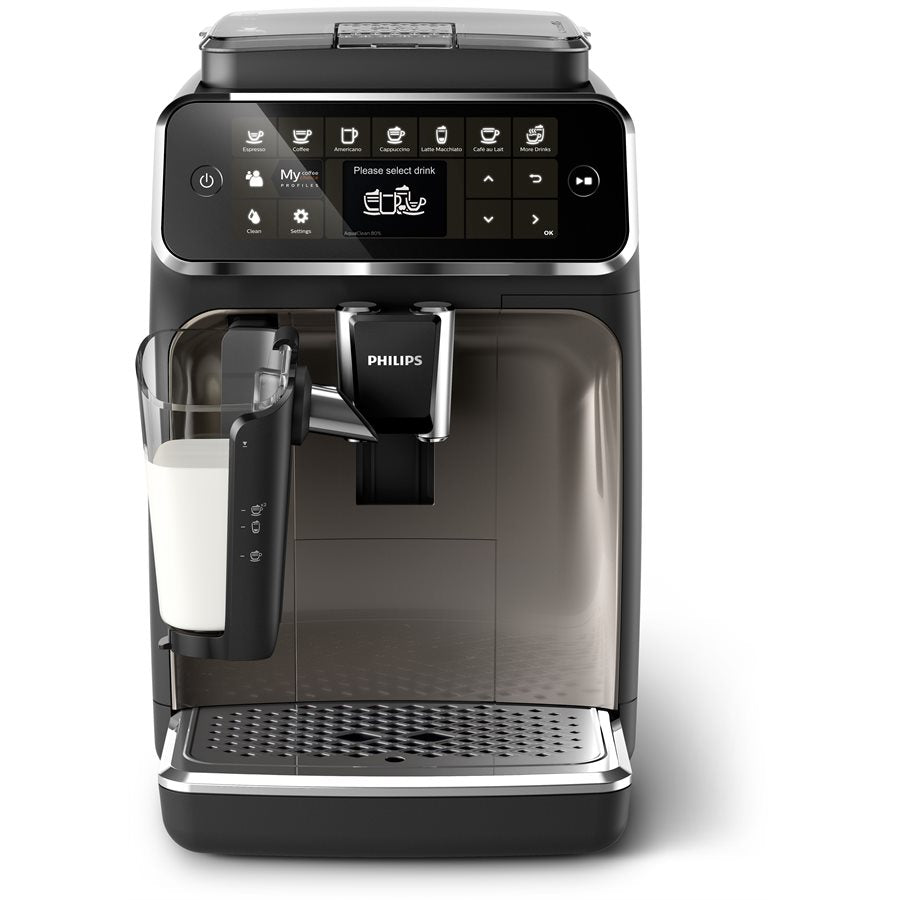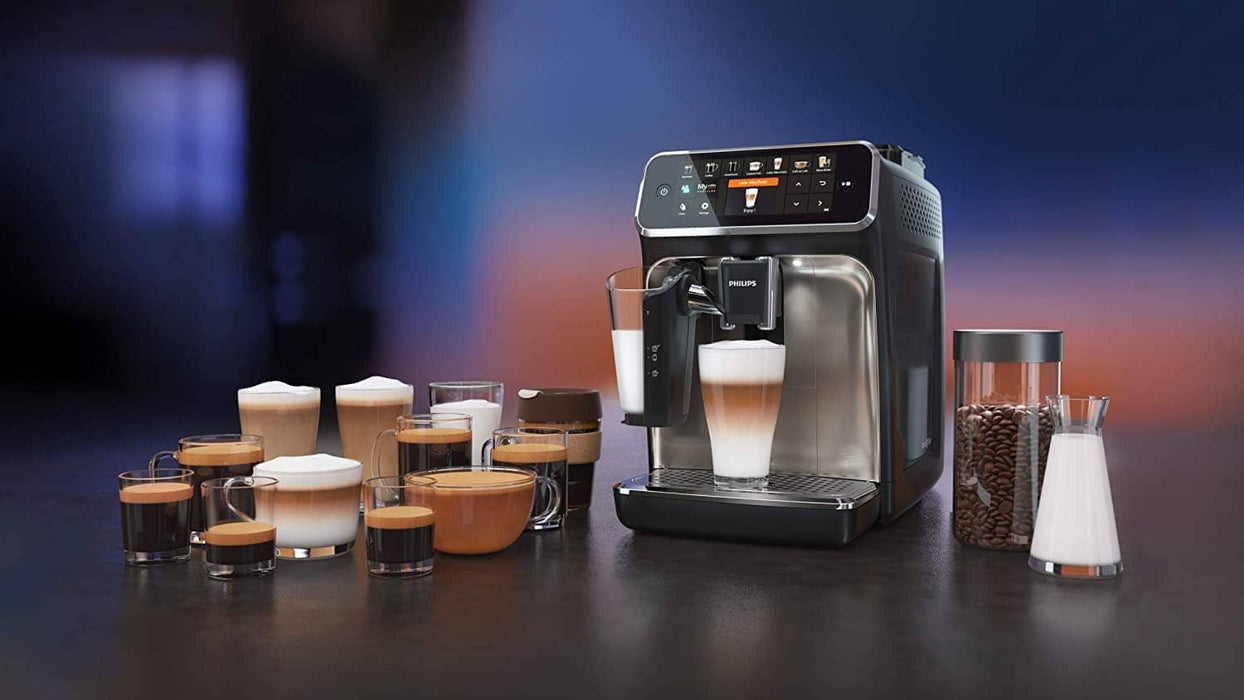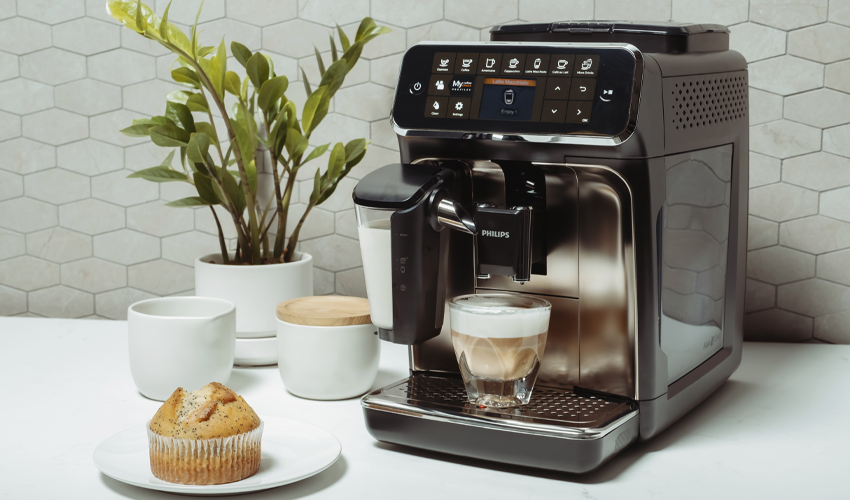#1: Philips LatteGo 5400

- Wide variety of drinks
- Advanced customization
- User profile options
#2: Philips LatteGo 4300

- Basic milk frother
- Small water tank
- Noisy grinder
As a dedicated coffee enthusiast, I've always been on the lookout for the ideal machine to simplify my mornings and satisfy my caffeine cravings. Like many, I’ve been drawn to the allure of automatic coffee makers, and that’s how I found myself comparing the Philips LatteGo 5400 vs 4300. These machines promise café-quality coffee at home, but the 5400 clearly stood out as the better choice for my needs. Here’s my experience with both and why I think the 5400 is the superior model.

What Sets the Philips LatteGo 5400 Apart?
The first thing that struck me about the Philips LatteGo 5400 was its versatility. While both models offer impressive features, the 5400 provides 12 drink options compared to the 8 on the 4300. This range was a game-changer for me. On busy mornings, I love a quick espresso, but on weekends, I enjoy indulging in a creamy latte or a velvety macchiato. The 5400 gave me the freedom to experiment with my coffee choices without feeling limited.
Beyond that, the display on the 5400 is a step above. The larger, more detailed touchscreen felt intuitive and modern. Navigating through the menus was seamless, and I never found myself fumbling to adjust the settings. This made the 5400 feel like a premium experience, while the 4300, though functional, felt a little outdated in comparison.
Coffee Quality and Flavor: Philips LatteGo 5400 vs 4300
Let’s face it—flavor is king when it comes to coffee. Both the Philips LatteGo 5400 and 4300 produce excellent brews, but I consistently noticed a richer, more balanced flavor with the 5400. This could be due to its finer control over strength, temperature, and coffee-to-milk ratio.
I also appreciated how customizable the coffee was on the 5400. With the ability to save my preferred settings, I didn’t have to reconfigure the machine every time. For instance, my go-to cappuccino recipe requires slightly less foam and more espresso, and the 5400 remembered this perfectly. The 4300, while offering some level of customization, lacked the precision and memory features of its higher-end sibling.
Ease of Use for Daily Coffee Drinkers
Using the Philips LatteGo 5400 was an absolute breeze. Setting it up took only a few minutes, thanks to its user-friendly instructions. Once I got the hang of it, making coffee became a simple, almost meditative part of my routine.
What I particularly appreciated was how quietly the 5400 operated. As someone who starts my mornings early, this was a big plus—it didn’t wake up the entire house while grinding beans or frothing milk. In contrast, the 4300, while not excessively noisy, didn’t have the same whisper-quiet functionality.

Cleaning and Maintenance: A Comparison
Maintaining a coffee machine is often a chore, but the LatteGo milk system on both models made cleaning surprisingly easy. It’s a two-part system without any tubes, so I could simply rinse it under the tap or pop it in the dishwasher. That said, the 5400 provided proactive maintenance reminders, including descaling notifications and step-by-step guidance. This feature ensured that I never missed an essential cleaning step, keeping my machine in optimal condition with minimal effort.
Ideal Use Cases for the Philips LatteGo 5400
For those who love entertaining guests, the 5400 is a dream. Its ability to create a variety of drinks quickly and consistently meant that I could offer everything from espresso to flat whites without skipping a beat. I once hosted a small brunch, and the machine became the star of the event. Guests were impressed by the quality of their drinks, and I barely had to lift a finger.
Even for solo users, the 5400 shines. It’s an investment for anyone who enjoys crafting their ideal coffee every day without needing to visit a café. I work from home and often take short breaks to recharge with a coffee, and having the 5400 made those moments feel indulgent.
Energy Efficiency: Why It Matters
Another standout feature of the Philips LatteGo 5400 is its energy-saving functionality. The machine powers down automatically when not in use, which is perfect for someone like me who occasionally forgets to turn off appliances. Over time, this feature made me feel confident that I wasn’t wasting electricity unnecessarily. While the 4300 also includes energy-saving capabilities, the 5400’s more advanced settings make it slightly more efficient.

Milk Frothing: A Game-Changer for Lattes and Cappuccinos
If you’re a fan of milk-based drinks, the LatteGo frothing system will be a revelation. While both the 5400 and 4300 use the same system, I noticed that the 5400’s froth had a consistently creamy texture. It worked perfectly for creating silky lattes and airy cappuccinos. The system’s simplicity also meant that I didn’t hesitate to use it daily, knowing cleanup was quick and painless.
Why the 5400 Is Worth the Upgrade
While the Philips LatteGo 4300 is an excellent machine in its own right, the 5400 feels like a leap forward. The added drink options, superior customization, and advanced interface elevate the coffee-making experience. For anyone who values variety, convenience, and high-quality coffee, the 5400 is undoubtedly the better choice.
That said, I don’t think the 4300 is a bad machine—it’s just better suited for someone with simpler coffee needs. If you’re content with a handful of drink options and don’t require advanced features, the 4300 will do just fine. But for me, coffee is more than just a drink; it’s an experience. That’s why I found myself gravitating toward the 5400.
Product Review Conclusion: Philips LatteGo 5400 vs 4300
After weeks of using both the Philips LatteGo 5400 and 4300, it’s clear to me that the 5400 is the better choice for most coffee lovers. From its intuitive interface to its wide range of drink options, the 5400 consistently delivers a superior experience. Whether you’re brewing a quick espresso or impressing friends with lattes and cappuccinos, this machine does it all effortlessly.
The 4300 is a solid option for those who need a reliable machine for basic coffee drinks, but if you’re someone like me who values versatility and customization, the 5400 is worth the extra investment. It’s become an essential part of my daily routine, and I can confidently say it’s a purchase I’ll enjoy for years to come.
Frequently Asked Questions: Philips LatteGo 5400 vs 4300
Q: Is the Philips LatteGo 5400 significantly better than the 4300?
A: In my experience, yes. The 5400 offers more customization options, a larger display, and a broader range of drink selections compared to the 4300. The coffee quality is also more consistent with the 5400, and its milk frothing system creates creamier results. For anyone who enjoys a variety of drinks or values convenience, the 5400 is definitely the better choice.
Q: What types of drinks can the Philips LatteGo 5400 make?
A: The Philips LatteGo 5400 offers 12 different drink options, including espresso, cappuccino, latte, flat white, macchiato, and more. It even allows you to customize your drinks to suit your personal taste, so you can adjust the strength and size of your beverages easily.
Q: How does the milk frothing system on the 5400 compare to the 4300?
A: Both models use the same LatteGo milk system, which is incredibly easy to clean and produces frothy milk without any complicated tubes or parts. However, I found that the froth on the 5400 was consistently creamier and denser, which made a noticeable difference when preparing lattes and cappuccinos.
Q: Is the Philips LatteGo 5400 difficult to clean and maintain?
A: Not at all! One of the highlights of the Philips LatteGo 5400 is how easy it is to clean. The milk system can be rinsed under the tap or placed in the dishwasher. Plus, the 5400 has helpful reminders to descale and clean the machine, so you never miss an important maintenance step. It’s designed for minimal effort, making daily upkeep a breeze.
Q: Does the Philips LatteGo 5400 have a silent operation feature?
A: Yes, the 5400 operates more quietly than the 4300. It’s not completely silent, of course, but it’s quiet enough that it won’t disrupt your morning routine, especially if you enjoy brewing coffee before the rest of the house wakes up.
Q: How long does it take to make a cup of coffee on the 5400?
A: On average, a regular espresso or cappuccino takes about 30 to 45 seconds to brew on the 5400, depending on your selected settings. It’s fast enough for busy mornings, but the machine doesn’t compromise on quality for the sake of speed.
Q: Can the Philips LatteGo 5400 save personalized coffee preferences for multiple users?
A: Yes, the 5400 allows you to set up multiple user profiles, each saving its own coffee preferences. This is particularly useful if you’re sharing the machine with others who have different coffee preferences. You can save your custom settings for strength, size, and milk froth, and it remembers them for future use.
Q: Is the Philips LatteGo 5400 energy-efficient?
A: Absolutely! The 5400 features energy-saving settings, including an automatic shut-off function and an eco mode. These features help minimize power usage, so you don’t have to worry about leaving the machine on when you’re not using it. It's a great option for anyone looking to save on energy bills.
Q: Is the 4300 a good option for someone who only drinks espresso?
A: If you’re primarily an espresso drinker and don’t mind limited customization, the 4300 might be a good choice for you. It still delivers excellent espresso, but if you plan to enjoy a variety of drinks or need more flexibility in your coffee options, I’d recommend the 5400 instead.
Q: Does the Philips LatteGo 5400 require a water filter?
A: The 5400 doesn’t come with a built-in water filter, but it does have a separate water filter that can be purchased if you prefer to use filtered water for your coffee. While the machine works perfectly fine without one, using filtered water can improve the taste of your coffee and prolong the life of the machine by reducing mineral build-up.
